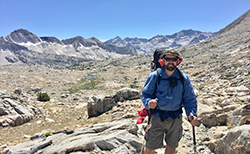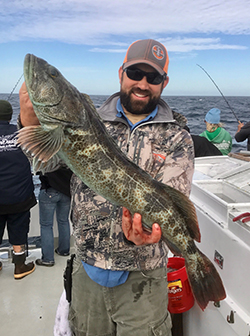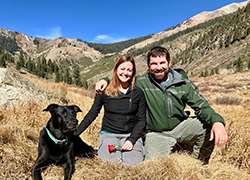Since 2010, Evan King has been CDFW’s wildlife biologist for Kings and Tulare counties. He is based in Visalia, just about two hours south of where he grew up. Born in Turlock and raised in Denair, Evan King is a third-generation biologist.

Backpacking remains one of Evan’s outdoor passions – along with gardening, fishing and hunting. He’s pictured here in 2016 near Bishop Pass on the southeast side of the Sierra.

Evan King shows off a lingcod he caught last year off of Morro Bay.

Evan, his wife, Renee, and their dog Madison hike in the Mineral King area within Sequoia National Park.
Since 2010, Evan King has been CDFW’s wildlife biologist for Kings and Tulare counties. He is based in Visalia, just about two hours south of where he grew up. Born in Turlock and raised in Denair, Evan King is a third-generation biologist. His grandfather, Frank H. King, worked for the Wisconsin Department of Natural Resources, and his father, Holman E. King, spent more than 30 years as a wildlife biologist for the California Department of Fish and Game assigned to Stanislaus County.
Evan got an early education in Central Valley wildlife as he often accompanied his dad on deer and waterfowl surveys and human-wildlife conflicts. He later earned a degree in wildlife management from Humboldt State University.
Given your family background, was it inevitable that you would one day work for the California Department of Fish and Wildlife?
My dad encouraged me to go to Humboldt State because a lot of people he worked with at the department also went to Humboldt and because wildlife always has been something I was interested in. But getting a job with the department wasn’t necessarily a goal or a push or anything. It just happened to be the right fit for me.
How did you come to work for CDFW, then?
When I graduated from Humboldt, some roommates and I attempted to hike the Pacific Crest Trail. I did all of California – the whole state, just shy of 1,600 miles in over 100 days. Thirty miles from the Oregon border, I got word of a scientific aid job opening with the Wildlife Investigations Lab near Sacramento. A friend of mine worked there and had put in a good word. I didn’t have a huge plan about what I was going to do after the hike so I dropped off the trail and took the job working for Dr. Pam Swift in the lab.
Four months after that, I got hired permanently as a biologist at the Mendota Wildlife Area. Full-time positions were hard to find back then, and as far as I was concerned it was a dream job for me at the age of 25. It was a permanent job with good pay and was an hour and a half away from where I grew up. I could go home on weekends and spend time with my family.
How long did you work at Mendota?
About four years. I was there from 2006 to 2010. I was in charge of all the water for the 13,000 acres of property. I did raptor surveys, breeding waterfowl pair surveys, duck banding, pheasant counts. I talked to all the hunters. I also learned how to repair irrigation problems, fix damage caused by beavers, and maintain flood control structures. It was a great place to cut your teeth as a biologist. Plus, I lived on the property and got to have my dog with me all the time. I hunted all the time. Life was good.
Many Californians have never visited Kings or Tulare County. What can you tell us about those places?
Kings County is mostly agricultural. Central Valley agriculture dominates the landscape and there are a lot of dairies. We’ve got some sensitive species there – tricolored blackbirds and San Joaquin kit foxes. Swainson’s hawks migrate from Argentina to spend their summers in Kings County. It’s more diverse than most people think.
Tulare County is pretty amazing. There are two national parks, a national forest and three wilderness areas all within the county. We’ve got Sequoia and Kings Canyon national parks, the Sequoia National Forest and parts of the Golden Trout Wilderness and South Sierra Wilderness. It encompasses the crest of the Sierra. If I were to drive from one end of Tulare County to the other, it would take me several hours.
What do you like best about your job?
I like the diversity. One day I am out darting a bear that’s in a backyard and the next day I’m checking for signs of porcupine in the national forest. One day I could be writing a report and another day I could be out trapping nutria. I’m about to learn how to be a drone pilot. So it’s a lot of fun, and I get to use a lot of different skills.
There are people who volunteer and take time off of their work to come and do my job – to help on deer surveys or band doves or whatever the project might be that needs extra hands. For the past 10 years, I haven’t felt like I’ve gone to work at all. I enjoy it so much. It’s not just a job. It’s a big part of who I am.
We don’t hear much about porcupines. What’s happening with porcupines?
There’s a statewide study taking place. We’re trying to develop a technique to detect porcupines without using cameras. Porcupines are salt-driven. They want salt, need salt in their diet. So if we take a stick that is really salty and put it out there in the forest, will a porcupine be drawn to it and, if so, will they chew on it? If they do chew on it, are the chew marks distinctive enough to positively identify the animal as a porcupine or do we need to use a trail camera? Trail cameras are expensive. I can put out a thousand salty sticks – but not a thousand trail cameras.
So how are porcupines doing?
Well, it’s concerning since I haven’t detected one yet. We have biologists in Tuolumne, Madera and Fresno counties that are helping me with this project who haven’t detected them either. Porcupines once were quite common in our forests and now we never see them. They’ve had detections in Yosemite so at least we know they are up there. We are trying to detect them over an area that includes three national forests so there is a lot of ground to cover, but I am hopeful that we will find one eventually.
You were among the first wildlife biologists in the state assigned to the nutria eradication effort. What’s one message you’d like to share about nutria?
I think people just need to know the potential destructiveness. Nutria have the potential to destroy what is left of our native habitat – the very small amount of wetlands we have left that millions of waterfowl and other native species rely on. To have an animal that is not native potentially destroy our native habitat and make it disappear – people need to know that impact. People need to understand how important it is to identify nutria and let us know where they are.
Tell us something about yourself people would be surprised to learn.
I met my wife, Renee, banding doves and we got married on the property where I still band doves. I was living on the same street as I do now in Visalia. I needed a place to band doves, and 500 yards down the street was her parents’ property. Their son is a biologist, and I asked them if I could use their property, put out some traps. I got to know the family. They invited me to dinner, and I met Renee. We got married in May.
Photos courtesy of Evan King. Top Photo: Surveying local deer and elk populations is a routine part of Evan’s responsibilities. Here he collects vital statistics from a tule elk near the San Luis Reservoir in Merced County.